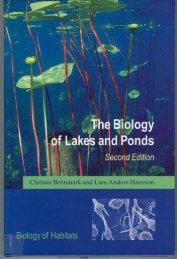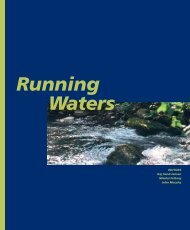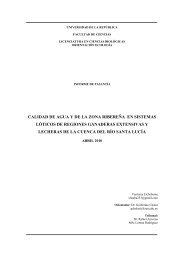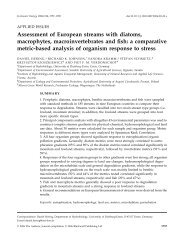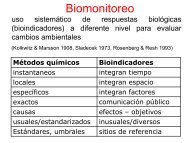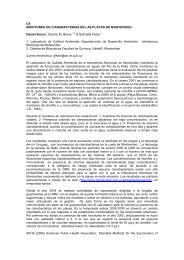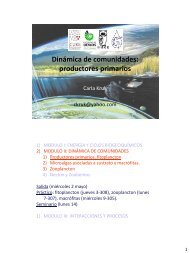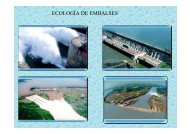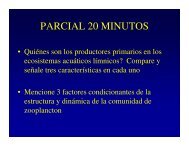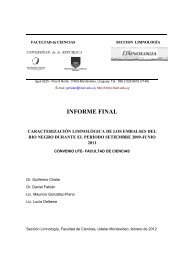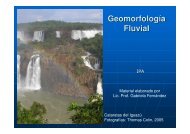Biomass of autotrophic picoplankton in subtropical coastal lagoons ...
Biomass of autotrophic picoplankton in subtropical coastal lagoons ...
Biomass of autotrophic picoplankton in subtropical coastal lagoons ...
Create successful ePaper yourself
Turn your PDF publications into a flip-book with our unique Google optimized e-Paper software.
Limnetica, 26 (2): 441-452 (2007)<br />
c○ Asociación Ibérica de Limnología, Madrid. Spa<strong>in</strong>. ISSN: 0213-8409<br />
Limnetica, 26 (2): 11-xx (2007)<br />
<strong>Biomass</strong> <strong>of</strong> <strong>autotrophic</strong> <strong>picoplankton</strong> <strong>in</strong> <strong>subtropical</strong> <strong>coastal</strong> <strong>lagoons</strong>:<br />
Is it relevant?<br />
Leticia Vidal 1,∗ , Lorena Rodríguez-Gallego 1 , Daniel Conde 1 , Wilner Martínez-López 2 and<br />
Sylvia Bonilla 1<br />
1 Sección Limnología, Facultad de Ciencias, Universidad de la República, Iguá 4225, CP 11400, Montevideo, Uruguay.<br />
2 Servicio de Clasificación Celular y Citometría de Flujo, Instituto de Investigaciones Biológicas Clemente Estable, Av. Italia<br />
3318, CP 11600, Montevideo, Uruguay.<br />
2<br />
∗ Correspond<strong>in</strong>g author: leti@fcien.edu.uy<br />
ABSTRACT<br />
<strong>Biomass</strong> <strong>of</strong> <strong>autotrophic</strong> <strong>picoplankton</strong> <strong>in</strong> <strong>subtropical</strong> <strong>coastal</strong> <strong>lagoons</strong>: Is it relevant?<br />
The importance <strong>of</strong> the <strong>autotrophic</strong> <strong>picoplankton</strong> (APP,
442 Vidal et al.<br />
INTRODUCTION<br />
Autotrophic <strong>picoplankton</strong> (APP, < 2 μm) is the<br />
ma<strong>in</strong> contributor to phytoplankton biomass and<br />
primary production <strong>in</strong> open oceans (Worden et<br />
al., 2004). Ever s<strong>in</strong>ce the discovery <strong>of</strong> different<br />
phylogenetic groups among picophytoplankton,<br />
the diversity <strong>of</strong> this fraction has received more attention<br />
<strong>in</strong> <strong>coastal</strong> (Hall & V<strong>in</strong>cent, 1990; Díez et<br />
al., 2001) and freshwater environments (Callieri<br />
& Stockner, 2002). These small phototrophic organisms,<br />
both prokaryotic and eukaryotic, constitute<br />
an essential component <strong>of</strong> microbial food<br />
webs, play<strong>in</strong>g a significant role <strong>in</strong> the major biogeochemical<br />
cycles <strong>of</strong> <strong>coastal</strong> waters (Courties et<br />
al., 1994; Li et al., 2001; Bec et al., 2004; Not et<br />
al., 2004; Rodríguez et al., 2005).<br />
The dom<strong>in</strong>ance <strong>of</strong> APP is generally associated<br />
with oligotrophic systems, where primary production<br />
is ma<strong>in</strong>ly susta<strong>in</strong>ed by nutrient regeneration<br />
through the microbial loop (Stockner, 1991;<br />
Chisholm, 1992). Under these conditions, these<br />
small sized organisms have competitive advantages<br />
<strong>in</strong> relation to bigger cells (Suttle et al., 1987;<br />
1988). An <strong>in</strong>verse trend between the relative contribution<br />
<strong>of</strong> APP to total <strong>autotrophic</strong> carbon fixation<br />
and the trophic state is accepted (Petersen,<br />
1991; Stockner, 1991), although Stockner et al.<br />
(2000) po<strong>in</strong>ted out that this trend is highly variable<br />
and difficult to predict.<br />
Sal<strong>in</strong>ity is another important factor that <strong>in</strong>fluences<br />
phytoplankton composition and growth<br />
<strong>in</strong> <strong>coastal</strong> ecosystems (Day et al., 1989). Investigations<br />
carried out <strong>in</strong> systems with sal<strong>in</strong>ity gradients<br />
showed that picophytoplankton abundance<br />
presented a bimodal distribution, with peaks under<br />
both extremely low and high sal<strong>in</strong>ity conditions<br />
(Estrada et al., 2004).<br />
The term <strong>coastal</strong> lagoon covers diverse aquatic<br />
ecosystems <strong>in</strong>fluenced by both mar<strong>in</strong>e and<br />
terrestrial environments (Barnes, 1980; Knoppers,<br />
1994). The <strong>in</strong>teraction <strong>of</strong> hydrological forces,<br />
like horizontal flow, mix<strong>in</strong>g <strong>of</strong> the water<br />
column, water exchange with the ocean,<br />
and residence times, modulates the function<strong>in</strong>g<br />
<strong>of</strong> these ecosystems. The connection with the<br />
ocean determ<strong>in</strong>es large variations <strong>in</strong> the physical<br />
and chemical conditions like sal<strong>in</strong>ity, turbi-<br />
dity, and nutrient concentration and consequently<br />
it also determ<strong>in</strong>es large variations <strong>in</strong> phytoplankton<br />
biomass, dom<strong>in</strong>ant size fractions, taxonomic<br />
groups, and life strategies (Barnes, 1980; Mukai,<br />
1987; Kjerfve, 1994; Macedo et al., 2001,<br />
Badylak & Phlips, 2004; Bonilla et al., 2005;<br />
Odebrecht et al., 2005).<br />
On the Atlantic coast <strong>of</strong> Uruguay there<br />
are a series <strong>of</strong> <strong>subtropical</strong> <strong>coastal</strong> <strong>lagoons</strong><br />
located <strong>in</strong> a MaB/UNESCO Biosphere World<br />
Reserve, which differ <strong>in</strong> size, depth, sal<strong>in</strong>ity,<br />
and human impact (Conde et al., 2003). These<br />
systems are extremely shallow and connect<br />
periodically with the ocean through a channel<br />
built on a sand bar. Most <strong>of</strong> the research<br />
performed on the phytoplankton structure<br />
<strong>in</strong> the <strong>coastal</strong> <strong>lagoons</strong> <strong>of</strong> Uruguay focused<br />
on the nano and microplanktonic fractions,<br />
composed ma<strong>in</strong>ly by diatoms and flagellates<br />
(Conde et al., 2002; Bonilla et al., 2005),<br />
and occasionally by cyanobacterial blooms,<br />
e.g. Nodularia spumigena (Pérez et al., 1999)<br />
and Pseudoanabaena sp. (Conde et al., 2005).<br />
However, recent studies showed that the APP<br />
fraction could represent more than half <strong>of</strong> the<br />
total phytoplanktonic chlorophyll a.<br />
The relative contribution <strong>of</strong> the <strong>autotrophic</strong><br />
eukaryotic (Pe) and prokaryotic (Pcy) <strong>picoplankton</strong>ic<br />
fractions to the total phytoplankton biomass<br />
<strong>in</strong> five <strong>subtropical</strong> <strong>coastal</strong> <strong>lagoons</strong> was determ<strong>in</strong>ed,<br />
and the relationship with selected environmental<br />
factors was analyzed. We hypothesized<br />
that (1) the relative contribution <strong>of</strong> <strong>picoplankton</strong>ic<br />
biomass has an <strong>in</strong>verse relationship<br />
with total phytoplankton biomass and (2) the<br />
relative contribution <strong>of</strong> <strong>picoplankton</strong> is higher<br />
under low nutrient availability.<br />
STUDY SITE<br />
Five <strong>coastal</strong> <strong>lagoons</strong> (from West to East: Laguna<br />
del Diario, Laguna de José Ignacio,<br />
Laguna Garzón, Laguna de Rocha, and Laguna<br />
de Castillos) were selected (Fig. 1). The<br />
climate <strong>of</strong> the region is <strong>subtropical</strong> (Bailey,<br />
1998) (historical annual air temperature for<br />
1951 − 1991 = 16.0 ◦ C) with ra<strong>in</strong>fall well distri-
Autotrophic <strong>picoplankton</strong> <strong>in</strong> <strong>subtropical</strong> <strong>coastal</strong> <strong>lagoons</strong> 443<br />
Figure 1. Location <strong>of</strong> the studied <strong>lagoons</strong> <strong>in</strong> Uruguay: D<br />
=Diario,J=José Ignacio, G = Garzón, Rocha, and C =<br />
Castillos. Localización de las lagunas estudiadas en Uruguay:<br />
D = Diario, J = José Ignacio, G = Garzón, Rocha y C =<br />
Castillos.<br />
buted throughout the year (historical annual<br />
ra<strong>in</strong>fall for 1951 − 1991 = 1105 mm).<br />
In general, size, watershed area, and depth<br />
<strong>of</strong> the <strong>lagoons</strong> <strong>in</strong>crease from Diario to Castillos,<br />
while the human impact is more important<br />
<strong>in</strong> Diario. The connection with the ocean<br />
is variable between these systems. Rocha,<br />
Garzón, and J. Ignacio connect to the Atlantic<br />
Ocean through a channel on a sand bar,<br />
Castillos through a 10 km stream, and Diario<br />
lost its natural connection by the construction<br />
<strong>of</strong> a <strong>coastal</strong> road. As a consequence, the mar<strong>in</strong>e<br />
<strong>in</strong>fluence between systems is highly variable,<br />
with values <strong>of</strong> conductivity rang<strong>in</strong>g from 0.2 to<br />
21.4 mS/cm (Bonilla et al., 2006).<br />
Accord<strong>in</strong>g to previous <strong>in</strong>vestigations <strong>in</strong> these<br />
<strong>lagoons</strong>, soluble reactive phosphorous (SRP)<br />
concentration fluctuates between 23 and 76μg/l,<br />
dissolved <strong>in</strong>organic nitrogen (DIN) between 6.7<br />
and 126μg/l, and the atomic ratio DIN/SRP is<br />
generally low (
444 Vidal et al.<br />
two fluorescent parameters (FL2 = 585/42 and<br />
FL3 = 675/20) were employed to discrim<strong>in</strong>ate<br />
photosynthetic cells by size and fluorescence<br />
properties. The FL2 signal corresponds to<br />
phycoerythr<strong>in</strong> and the FL3 to chlorophyll.<br />
Yellow-green latex Polysciences beads <strong>of</strong> 2 and<br />
6 μm diluted <strong>in</strong> phosphate buffer sal<strong>in</strong>e solution<br />
(PBS) were employed as reference sizes.<br />
Chl-a concentration was determ<strong>in</strong>ed for total<br />
phytoplankton and picophytoplankton. Samples<br />
(0.3 to 1 l) were filtered either directly onto<br />
Whatman GF/F filters (for the total fraction) or<br />
through 3 μm pore size polycarbonate filters and<br />
then onto GF/F (for the <strong>picoplankton</strong> fraction).<br />
The filters were frozen at −20 ◦ C until analysis.<br />
Phytoplankton Chl-a was extracted follow<strong>in</strong>g<br />
sonication (1.5 m<strong>in</strong>) <strong>in</strong> 5 ml <strong>of</strong> 90 % acetone and<br />
kept overnight <strong>in</strong> darkness at 4 ◦ C. The extracts<br />
were cleared by filtration through GF/C filters and<br />
analyzed <strong>in</strong> a Beckman UV-Vis spectrophotometer<br />
at 663 nm before and after acidification with HCl<br />
0.12 N (Wetzel & Likens, 1991).<br />
Data analyses<br />
S<strong>in</strong>ce data was not normally distributed both before<br />
and after simple transformations, the differences<br />
<strong>in</strong> abiotic and biotic variables between <strong>lagoons</strong><br />
and between stations (N and S) were tested<br />
us<strong>in</strong>g the Kruskall-Wallis (K-W) nonparametric<br />
test. We performed a Kendall nonparametric<br />
correlation (K, τ = Tau) <strong>in</strong> order to test correlations<br />
between pairs <strong>of</strong> variables. To analyze the<br />
relationship between APP and ma<strong>in</strong> abiotic variables<br />
we ran a multivariate ord<strong>in</strong>ation method, the<br />
Pr<strong>in</strong>cipal Component Analysis (PCA) (Ter Braak<br />
& Smilauer, 1998), us<strong>in</strong>g forward selection method<br />
the follow<strong>in</strong>g variables were selected: K,<br />
SS, Kd, DIN/SRP and APP relative contribution<br />
to total Chl-a(% APP Chl-a).<br />
Table 1. Mean and standard deviation (between brackets) <strong>of</strong> abiotic variables <strong>in</strong> the North (N) and South (S) stations <strong>of</strong> the studied<br />
<strong>lagoons</strong>: depth (Z), conductivity (K), temperature (T), soluble reactive phosphorous (SRP), dissolved <strong>in</strong>organic nitrogen (DIN),<br />
DIN/SRP atomic ratio, reactive silica (RS), and suspended solids (SS). Codes for <strong>lagoons</strong> as <strong>in</strong> Figure 1. (nd = below the detection<br />
limit <strong>of</strong> the method, — = no data). Promedio y desvío estándar (entre paréntesis) de las variables abióticas en las estaciones del<br />
Norte (N) y Sur (S) de las lagunas estudiadas: pr<strong>of</strong>undidad (Z), conductividad (K),temperatura (T), fósforo reactivo soluble (SRP),<br />
nitrógeno <strong>in</strong>orgánico disuelto (DIN), relación atómica DIN/SRP, sílice reactivo (SR) y sólidos en suspensión (SS). Códigos para las<br />
lagunas como en la Figura 1. (nd = debajo del límite de detección del método, — = s<strong>in</strong> datos)<br />
D JI G R C<br />
N S N S N S N S N S<br />
Z(m) 1.5 1.7 0.3 0.3 0.7 0.9 0.5 0.6 1.3 1.0<br />
(0.1) (0.1) (0.1) (0.1) (0.6) (0.7) (0.2) (0.3) (0.4) (0.4)<br />
K (mS/cm) 0.7 0.8 12.8 23.6 5.4 15.1 15.7 19.7 5.3 5.4<br />
(0.4) (0.4) (17.7) (13.7) (4.7) (9.3) (8.1) (7.9) (4.4) (5.6)<br />
T( ◦ C) 18.6 18.9 19.7 20.9 18.6 20.3 20.7 19.8 18.8 17.9<br />
(2.9) (3.3) (2.8) (2.8) (2.9) (4.1) (4.7) (4.5) (3.6) (4.1)<br />
SRP (μg/l) 19.0 19.0 9.5 14.1 12.4 12.7 19.2 14.4 26.4 26.9<br />
(21.2) (17.8) (7.5) (7.5) (11.1) (7.9) (17.1) (9.0) (9.5) (11.7)<br />
DIN (μg/l) 30.5 6.9 3.2 nd 8.7 13.8 4.7 nd 28.8 33.3<br />
(27.2) (13.8) (1.7) (17.5) (18.8) (4.0) (5.4) (50.1)<br />
DIN/SRP 18.0 0.7 1.2 — 13.0 9.3 0.9 — 1.8 1.9<br />
(30.8) (1.4) (0.8) (26.0) (16.7) (1.3) (2.4) (2.5)<br />
RS (mg/l) 2.1 2.2 2.9 1.5 0.3 1.9 1.6 0.8 1.8 1.9<br />
(1.5) (1.5) (1.7) (1.7) (1.7) (1.4) (1.3) (0.4) (0.5) (1.1)<br />
SS (mg/l) 19.2 12.4 25.4 14.6 34.1 52.0 51.3 19.6 38.1 40.8<br />
(12.4) (11.1) (6.7) (6.7) (14.3) (41.9) (40.4) (12.7) (36.7) (59.9)
RESULTS<br />
Abiotic factors<br />
Autotrophic <strong>picoplankton</strong> <strong>in</strong> <strong>subtropical</strong> <strong>coastal</strong> <strong>lagoons</strong> 445<br />
Water temperature varied between 15 and 25.7 ◦ C,<br />
with a mean for all systems <strong>of</strong> 23 ± 1.3 ◦ C<strong>in</strong><br />
summer and 16.5 ± 1 ◦ C <strong>in</strong> w<strong>in</strong>ter (Table 1).<br />
Conductivity was significantly different between<br />
the five <strong>lagoons</strong> (K-W, H = 7.5, p < 0.01) (Table<br />
1). Diario presented the m<strong>in</strong>imum conductivity<br />
(0.3 mS/cm) (station N, May 2005) and exhibited<br />
significant differences from the rest <strong>of</strong> the <strong>lagoons</strong><br />
(p < 0.05). On the other hand, J. Ignacio presented<br />
the maximum conductivity (36.6 mS/cm) at<br />
station S <strong>in</strong> February 2005. Castillos presented<br />
conductivity values significantly lower than Rocha<br />
(K-W, H = 7.5, p < 0.01) and J. Ignacio (K-W, H<br />
=4.4,p < 0.05). The pH was close to neutrality <strong>in</strong><br />
all systems (mean = 7.5 ± 0.5) and the dissolved<br />
oxygen values <strong>in</strong>dicated over-saturation dur<strong>in</strong>g the<br />
entire study (data not shown).<br />
DIN concentration was generally low (Table<br />
1) and highly variable (mean = 13.5 μg/l,<br />
range < 1 - 107.2 μg/l), however no significant<br />
differences were found between <strong>lagoons</strong> (K-<br />
W, p > 0.05). The maximum DIN concentration<br />
was detected <strong>in</strong> Castillos (107.2 μg/l, station S,<br />
November 2005). The DIN/SRP atomic ratio was<br />
generally low (mean = 3.3), rang<strong>in</strong>g from < 1<br />
to 52.3, and the highest values were observed<br />
<strong>in</strong> Garzón <strong>in</strong> August (52.1, station N and<br />
32.4, station S). Conductivity was negatively<br />
correlated with DIN, DIN/SRP, and Kd (K,<br />
p
446 Vidal et al.<br />
Figure 3. Relative abundance <strong>of</strong> eukaryotic (white bars)<br />
and prokaryotic (black bars) organisms to total APP (%)<br />
determ<strong>in</strong>ed by flow cytometry <strong>in</strong> the North (top) and South<br />
(bottom) stations <strong>of</strong> the <strong>lagoons</strong>. Codes for <strong>lagoons</strong> as <strong>in</strong> Figure<br />
1. Abundancia relativa de organismos eucariotas (barras<br />
blancas) y procariotas (barras negras) respecto al <strong>picoplankton</strong><br />
autótr<strong>of</strong>o (APP, %) determ<strong>in</strong>ados mediante citometría de flujo<br />
en las estaciones Norte (arriba) y Sur (abajo) de las lagunas.<br />
Códigos de las lagunas como en la Figura 1.<br />
Total Chl-a varied between 0.2 and 18.7 μg/l<br />
(mean = 5 μg/l) (Fig. 2). The maximum value<br />
was found <strong>in</strong> Rocha (station N, February 2005)<br />
and the m<strong>in</strong>imum <strong>in</strong> J. Ignacio (station N, May<br />
2005). Chl-a was significantly different between<br />
Garzón and Diario (K-W, H = 3.9, p < 0.05)<br />
and between Garzón and J. Ignacio (K-W, H =<br />
7.5, p < 0.01) (Fig. 2). However, no significant<br />
differences were found when stations N and S<br />
were compared between all <strong>lagoons</strong> and with<strong>in</strong><br />
each system (K-W, p > 0.05).<br />
The contribution <strong>of</strong> APP to the total Chl-a was<br />
highly variable, rang<strong>in</strong>g from 4.2 to 96.6 % (mean<br />
= 30.5 %) (Fig.2). However, a general <strong>in</strong>verse<br />
significant correlation was found between total Chl-a<br />
and % APP Chl-a (K, τ=0.4, p 0.05)(Fig.2).<br />
The relative contribution <strong>of</strong> <strong>picoplankton</strong>ic<br />
groups to the total APP analyzed showed that<br />
Pe (G1, G2, G3, and G6) was more important<br />
than Pcy (G4 and G5) (Fig. 3). Populations <strong>of</strong><br />
picoeukaryotes with high fluorescence detected<br />
<strong>in</strong> FL3 (G1) represented a high percentage<br />
<strong>of</strong> total <strong>picoplankton</strong> <strong>in</strong> all systems, with the<br />
highest contribution <strong>in</strong> J. Ignacio (35.2-58.7 %<br />
<strong>of</strong> total APP). The picoeukaryote group with<br />
low fluorescence <strong>in</strong> FL3 (G3) exhibited high<br />
relative abundance <strong>in</strong> all <strong>lagoons</strong>, dom<strong>in</strong>at<strong>in</strong>g<br />
<strong>in</strong> Castillos (mean = 52.8 and 58.5 % <strong>of</strong> APP,<br />
for N and S station, respectively) and Diario<br />
(mean = 40 and 42.5 %). However, this group<br />
presented its lowest contribution <strong>in</strong> Rocha<br />
station N (mean = 7.5 %, N station). The group<br />
with high fluorescence <strong>in</strong> FL3 but low <strong>in</strong> FL2<br />
(G6), tentatively assigned as cryptomonads,<br />
was present <strong>in</strong> all <strong>lagoons</strong>, with the highest<br />
contribution <strong>in</strong> Rocha (mean = 35.7 and 42.5 %<br />
for N and S station respectively).<br />
Although Pe was the APP dom<strong>in</strong>ant group<br />
<strong>in</strong> most cases, the prokaryote population determ<strong>in</strong>ed<br />
as cyanobacteria (G5) was always detected.<br />
Moreover, <strong>in</strong> some occasions, Pcy dom<strong>in</strong>ated<br />
the APP (99 % <strong>of</strong> the total, Garzón: February<br />
and May 2005, Diario; February 2005,<br />
and Rocha: May 2005). The groups with the<br />
lowest contribution were the picoeukaryote G2<br />
(registered only <strong>in</strong> Garzón, mean = 2 and 5 %<br />
for N and S station, respectively) and the unknown<br />
prokaryote G4, found <strong>in</strong> Garzón, J. Ignacio<br />
and Diario (mean = 2 and 3.5 % for N and<br />
S station, respectively).<br />
APP and environmental factors<br />
A negative correlation between % APP Chl-a and<br />
SS (K, τ = –0.3, p
Autotrophic <strong>picoplankton</strong> <strong>in</strong> <strong>subtropical</strong> <strong>coastal</strong> <strong>lagoons</strong> 447<br />
Figure 4. Relationship between APP relative Chl-a contribution<br />
to total Chl-a (% APP Chl-a) and dissolved <strong>in</strong>organic nitrogen<br />
concentration (DIN). Symbols for the <strong>lagoons</strong> are: squares<br />
= Diario, diamonds = J. Ignacio, down-triangles = Garzón, uptriangles<br />
= Rocha and circles = Castillos. Grey symbols correspond<br />
to North stations and white ones for South stations. Relación<br />
entre la contribución relativa de Chl-a del picoplancton<br />
autótr<strong>of</strong>o (APP) a la Chl-a total (% APP Chl-a) y la concentración<br />
de nitrógeno <strong>in</strong>orgánico disuelto (DIN). Los símbolos<br />
para la lagunas son: cuadrados= Diario, diamantes = J. Ignacio,<br />
triángulos hacia abajo= Garzón, triángulos hacia arriba =<br />
Rochaycírculos = Castillos. Los símbolos grises corresponden<br />
a las estaciones del Norte y los blancos a las del Sur.<br />
data were pooled and analyzed together. We<br />
also observed a negative trend between % APP<br />
Chl-a abundance and DIN concentration (K,<br />
τ = 0.21, p = 0.052) (Fig. 4). However, no clear<br />
tendencies were found neither between % APP<br />
Chl-a and conductivity nor between PPA and the<br />
DIN/SRP atomic ratio.<br />
The PCA analysis performed with the<br />
ma<strong>in</strong> abiotic variables and % APP Chl-a<br />
contribution showed that the first two axes<br />
expla<strong>in</strong>ed 82.9 % <strong>of</strong> the total variance (Fig. 5).<br />
The first axis (56.3 %) was ma<strong>in</strong>ly constructed<br />
by SS and Kd (positive) and secondly by<br />
% APP Chl-a (negative), while the second<br />
axis (26.5 %) was constructed by % APP<br />
Chl-a (positive) and DIN/SRP negative. The<br />
biplot representation showed an opposite<br />
trend between APP contribution and the<br />
concentration <strong>of</strong> SS. A clear opposite trend<br />
was also found between conductivity and<br />
DIN/SRP and Kd. In general, the samples were<br />
distributed randomly along the axes without<br />
clear patterns between <strong>lagoons</strong>.<br />
Figure 5. Results <strong>of</strong> the Pr<strong>in</strong>cipal Component Analysis<br />
(PCA) for the selected abiotic factors and APP relative Chla<br />
contribution to total Chl-a (% APP Chl-a). The percentage<br />
<strong>of</strong> the variance expla<strong>in</strong>ed by the PCA axes is <strong>in</strong>dicated <strong>in</strong><br />
parentheses. Symbols for <strong>lagoons</strong> as <strong>in</strong> Figure 4, and codes<br />
for variables as <strong>in</strong> Table 1 except light ext<strong>in</strong>ction coefficient,<br />
Kd. Resultados del Análisis de Componentes Pr<strong>in</strong>cipales (ACP)<br />
para los factores abióticos seleccionados y la contribución<br />
relativa de Chl-a del picoplancton autótr<strong>of</strong>o (APP) a la Chla<br />
total (% APP Chl-a). El porcentaje de la varianza explicada<br />
por los ejes del ACP se <strong>in</strong>dica en paréntesis. Símbolos para las<br />
lagunas como en la figura 4ycódigos para las variables como<br />
en la Tabla 1 excepto el coeficiente de ext<strong>in</strong>ción Kd.<br />
DISCUSSION<br />
The relevance <strong>of</strong> the <strong>autotrophic</strong> <strong>picoplankton</strong> for<br />
aquatic food webs has <strong>in</strong>tensified the <strong>in</strong>vestigations<br />
on these organisms. The range <strong>of</strong> <strong>coastal</strong><br />
shallow systems analyzed <strong>in</strong> this study, <strong>in</strong>clud<strong>in</strong>g<br />
typically brackish and freshwater <strong>lagoons</strong>, represents<br />
an opportunity to address the diversity and<br />
relevance <strong>of</strong> the <strong>picoplankton</strong> fraction.<br />
The total Chl-a concentration <strong>of</strong> the <strong>lagoons</strong><br />
was <strong>in</strong> the range previously found for some <strong>of</strong><br />
these systems (Conde et al., 1999; Bonilla et al.,<br />
2006) and other similar <strong>lagoons</strong> <strong>of</strong> the region<br />
(Abreu et al., 1994). In our study, we found on<br />
many occasions that the APP fraction reached<br />
a high percentage <strong>of</strong> the total phytoplankton<br />
biomass. The contribution <strong>of</strong> the APP was highly
448 Vidal et al.<br />
variable (4.2 to 96.6 %), especially at low total<br />
Chl-a concentrations. Phytoplankton studies <strong>in</strong><br />
tropical systems (e.g. Lagoa Imboassica and Lagoa<br />
Cabíunas, Rio de Janeiro) showed that APP<br />
can reach contributions up to 90 % <strong>of</strong> the total<br />
phytoplankton abundance (Melo & Suzuki, 1998)<br />
and between 23 to 37 % <strong>of</strong> total Chl-a (Roland,<br />
1998). Investigations <strong>in</strong> a <strong>coastal</strong> system <strong>in</strong> New<br />
Zealand revealed a significant contribution <strong>of</strong> APP<br />
to the total Chl-a, rang<strong>in</strong>g between 40 % and 80 %<br />
<strong>in</strong> w<strong>in</strong>ter (V<strong>in</strong>cent et al., 1989) and 55 % <strong>in</strong> summer<br />
(Hall & V<strong>in</strong>cent, 1990). We also found an <strong>in</strong>verse<br />
trend between the relative importance <strong>of</strong> APP Chla<br />
and the total Chl-a, co<strong>in</strong>cid<strong>in</strong>g with observations<br />
reported elsewhere ( Chisholm, 1992; Stockner et<br />
al., 2000; S<strong>in</strong> et al., 2000; Aubry et al., 2006).<br />
In our study, the APP biomass contribution to<br />
total phytoplankton biomass was greater under<br />
conditions <strong>of</strong> nitrogen limitation, evidenced by<br />
the <strong>in</strong>verse trend with DIN concentration. As<br />
proposed by studies performed <strong>in</strong> other <strong>coastal</strong><br />
systems (e.g. a river estuary transition zone, S<strong>in</strong><br />
et al., 2000), we also suggest that the nanomicroplankton<br />
fraction was limited by the low<br />
DIN concentrations and low DIN/SRP ratios. The<br />
traditional view for phytoplankton growth shows<br />
a limitation by nitrogen <strong>in</strong> mar<strong>in</strong>e systems and<br />
by phosphorus <strong>in</strong> limnic ones (Reynolds, 1984).<br />
However, some studies <strong>in</strong> both freshwater and<br />
mar<strong>in</strong>e systems (Klausmeier & Litchman, 2004;<br />
Odebrecht et al., 2005; Smith, 2006) revealed<br />
multiple resource limitation by nitrogen and<br />
phosphorus simultaneously.<br />
The species composition <strong>of</strong> the nanomicroplankton<br />
was similar to that found previously<br />
<strong>in</strong> these systems (Conde et al. 2005;<br />
Bonilla et al., 2005, 2006), composed ma<strong>in</strong>ly<br />
by diatoms and flagellates. Occasionally, we<br />
found some species (e.g pennate diatoms) that<br />
belong to benthic resuspended microalgae. It is<br />
well known for these shallow <strong>lagoons</strong> that w<strong>in</strong>d<br />
action and sediment resuspension enhances the<br />
contribution <strong>of</strong> benthic microalgae to the water<br />
column. Studies <strong>in</strong> Laguna de Rocha demonstrated<br />
that microphytobenthos is the dom<strong>in</strong>ant<br />
microalgal community <strong>in</strong> terms <strong>of</strong> biomass<br />
(> 80 % <strong>of</strong> the total) (Conde et al., 1999, 2003).<br />
The <strong>in</strong>verse relationship between APP biomass<br />
contribution and suspended solids and total<br />
Chl-aconcentration found <strong>in</strong> our study supports<br />
the idea that the nanoplankton is <strong>in</strong>fluenced<br />
by resuspended benthic algae, which <strong>in</strong> turn<br />
dim<strong>in</strong>ishes the relative contribution <strong>of</strong> APP.<br />
The six APP groups differentiated by flow<br />
cytometry suggest a diverse composition <strong>of</strong> this<br />
small fraction <strong>in</strong> most <strong>of</strong> the <strong>lagoons</strong>. The<br />
high diversity <strong>of</strong> the APP has been po<strong>in</strong>ted<br />
out recently for <strong>coastal</strong> systems (Díez et al.,<br />
2001; Estrada et al., 2004). The fact that the<br />
studied <strong>lagoons</strong> presented a high variability <strong>in</strong><br />
their conductivity values suggests that the APP<br />
is <strong>in</strong>tegrated by species adapted to different<br />
environments, from limnic to brackish.<br />
It has been reported that prokaryotes dom<strong>in</strong>ate<br />
<strong>in</strong> mar<strong>in</strong>e oligotrophic systems, (Partensky et<br />
al., 1999), while <strong>in</strong> more nutrient enriched<br />
<strong>coastal</strong> systems the importance <strong>of</strong> Pcy and Pe<br />
groups becomes variable (Hall & V<strong>in</strong>cent, 1990).<br />
However, the relative importance <strong>of</strong> Pe and Pcy<br />
fractions <strong>in</strong> the <strong>picoplankton</strong> is controversial<br />
and depends on local characteristics (Murrel<br />
& Lores, 2004). Our f<strong>in</strong>d<strong>in</strong>g <strong>of</strong> a general<br />
dom<strong>in</strong>ance <strong>of</strong> Pe <strong>in</strong> the APP fraction is <strong>in</strong><br />
good agreement with the proposed general trend<br />
for <strong>coastal</strong> brackish systems (Hall &V<strong>in</strong>cent,<br />
1990; Iriarte & Purdie, 1994), but also for<br />
freshwater ones (Chrétiennot-D<strong>in</strong>et et al., 1995).<br />
Moreover, Callieri & Stockner (2002) showed a<br />
relationship between the APP bulk composition<br />
and the trophic state, where Pe becomes more<br />
important <strong>in</strong> enriched systems.<br />
The results <strong>of</strong> our study suggest that nutrient<br />
availability <strong>in</strong> these <strong>subtropical</strong> brackish <strong>lagoons</strong><br />
(with a low and highly variable DIN/SRP ratio) is<br />
an important factor that determ<strong>in</strong>es the size distribution<br />
<strong>of</strong> the phytoplankton community. Melo<br />
& Suzuki (1998) suggest that sal<strong>in</strong>ity could determ<strong>in</strong>e<br />
the species composition <strong>of</strong> APP <strong>in</strong> tropical<br />
<strong>coastal</strong> <strong>lagoons</strong>, while other factors like availability<br />
<strong>of</strong> nutrients, temperature and graz<strong>in</strong>g control<br />
their growth. Conversely, for a <strong>subtropical</strong><br />
system (Lagoa dos Patos), Torgan et al. (2000)<br />
found that APP presented a high contribution <strong>in</strong><br />
brackish areas and suggested that phytoplankton<br />
size structure is determ<strong>in</strong>ed by a comb<strong>in</strong>ation<br />
<strong>of</strong> sal<strong>in</strong>ity, availability <strong>of</strong> nutrients, and se-
Autotrophic <strong>picoplankton</strong> <strong>in</strong> <strong>subtropical</strong> <strong>coastal</strong> <strong>lagoons</strong> 449<br />
lective graz<strong>in</strong>g pressure. The microzooplankton<br />
graz<strong>in</strong>g pressure, not considered <strong>in</strong> this study, is<br />
another factor that could play an important role<br />
<strong>in</strong> controll<strong>in</strong>g APP biomass <strong>in</strong> <strong>coastal</strong> systems.<br />
Our results suggest that <strong>in</strong> these <strong>subtropical</strong><br />
<strong>lagoons</strong>, the APP contribution to the total<br />
phytoplankton biomass is ma<strong>in</strong>ly related to the<br />
availability <strong>of</strong> nutrients, while sal<strong>in</strong>ity would<br />
play a key role <strong>in</strong> determ<strong>in</strong><strong>in</strong>g the composition<br />
<strong>of</strong> the APP community.<br />
ACKNOWLEDGEMENTS<br />
We thank Danilo Calliari, Anamar Britos, Erica<br />
Meerh<strong>of</strong>f, and Serrana García for field and<br />
laboratory assistance. This study was supported<br />
by grants from CSIC-I+D-UdelaR (C-O9), PDT-<br />
Uruguay (S/C/OP/36/09), and PEDECIBA.<br />
REFERENCES<br />
ABREU, P., C. ODEBRECHT & A. GONZALEZ.<br />
1994. Particulate and dissolved phytoplankton<br />
production <strong>of</strong> the Patos lagoon estuary, southern<br />
Brazil: comparison <strong>of</strong> methods and <strong>in</strong>fluenc<strong>in</strong>g<br />
factors. J. Plankton Res., 16: 737-735.<br />
AMERICAN PUBLIC HEALTH ASSOCIATION.<br />
1985. Standard Methods for the Exam<strong>in</strong>ation <strong>of</strong><br />
Water and Wastewater. APHA/AWWA/WPCF,<br />
Wash<strong>in</strong>gton, 1268 pp.<br />
AUBRY, F. B., F. ACRI, M. BASTIANINI, A. PUG-<br />
NETTI & G. SOCAL. 2006. Picophytoplankton<br />
Contribution to Phytoplankton Community Structure<br />
<strong>in</strong> the Gulf <strong>of</strong> Venice (NW Adriatic Sea). Internat.<br />
Rev. Hydrobiol., 91: 51-70.<br />
BADYLAK, S. & E. J. PHLIPS. 2004. Spatial and<br />
temporal patterns <strong>of</strong> phytoplankton composition<br />
<strong>in</strong> a <strong>subtropical</strong> <strong>coastal</strong> lagoon, the Indian River<br />
Lagoon, Florida, USA. J. Plankton. Res., 26: 1229-<br />
1247.<br />
BAILEY, R. G. 1998. Ecoregions: The ecosystems<br />
geography <strong>of</strong> the oceans and cont<strong>in</strong>ents, 1 st ed.<br />
New York: Spr<strong>in</strong>ger-Verlag. 176 pp.<br />
BARNES, R. S. K. 1980. Coastal <strong>lagoons</strong>. Cambridge:<br />
Cambridge University Press. 106 pp.<br />
BEC, B., J. HUSSEIN-RATREMA, Y. COLLOS, P.<br />
SOUCHU & A. VAQUER. 2005. Phytoplankton<br />
seasonal dynamics <strong>in</strong> a Mediterranean <strong>coastal</strong> lagoon:<br />
emphasis on the picoeukaryotic community.<br />
J. Plankton Res., 27: 881-894.<br />
BONILLA, S., D. CONDE, L. AUBRIOT & M a C.<br />
PÉREZ. 2005. Influence <strong>of</strong> hydrology on phytoplankton<br />
species composition and life strategies <strong>in</strong><br />
a <strong>subtropical</strong> costal lagoon periodically connected<br />
with the Atlantic Ocean. Estuaries, 28: 884-895.<br />
BONILLA, S., D. CONDE, L. AUBRIOT, L. RO-<br />
DRÍGUEZ-GALLEGO, C. PICCINI, E. MEER-<br />
HOFF, L. RODRÍGUEZ-GRAÑA, P. GÓMEZ<br />
y I. MACHADO. 2006. Escalas de variabilidad<br />
ecológica y evolución ambiental de las lagunas<br />
costeras de Uruguay. In: Bases para la conservación<br />
y el manejo de la costa uruguaya. Menafra,<br />
R., L. Rodríguez-Gallego, F. Scarab<strong>in</strong>o & D.<br />
Conde (eds.): 61-630. Montevideo.<br />
CALLIERI, C. & J. G. STOCKNER. 2002. Freshwater<br />
<strong>autotrophic</strong> <strong>picoplankton</strong>: a review. J. Limnol.,<br />
61: 1-14.<br />
CONDE, D., S. BONILLA, L. AUBRIOT, R. DE<br />
LEÓN & W. PINTOS. 1999. Comparison <strong>of</strong> the<br />
areal amount <strong>of</strong> chlorophyll a <strong>of</strong> planktonic and<br />
attached microalgae <strong>in</strong> a shallow <strong>coastal</strong> lagoon.<br />
Hydrobiologia, 408/409: 285-291.<br />
CONDE, D., L. AUBRIOT, S. BONILLA & R.<br />
SOMMARUGA. 2002. Mar<strong>in</strong>e <strong>in</strong>trusions <strong>in</strong> a<br />
<strong>coastal</strong> lagoon enhance the negative effect <strong>of</strong> solar<br />
UV radiation on phytoplankton photosynthetic<br />
rates. Mar. Ecol. Prog. Ser., 240: 57-70.<br />
CONDE, D., L. RODRÍGUEZ-GALLEGO y L. RO-<br />
DRÍGUEZ-GRAÑA. 2003.Análisis conceptual de<br />
las <strong>in</strong>teracciones abióticas y biológicas entre el<br />
océano y las lagunas de la costa atlántica de<br />
Uruguay. PNUD/GEF/RLA/99/G31 (FREPLATA-<br />
Ciencias 8). Sección Limnología, FC/UDELAR,<br />
Montevideo, 65 pp.<br />
CONDE, D., L. RODRÍGUEZ-GRAÑA, D. CA-<br />
LLIARI, P. ABREU, J. SELLANES, R. URRU-<br />
TIA & C. ODEBRECHT. 2005. Food web structure<br />
<strong>in</strong> two <strong>coastal</strong> <strong>lagoons</strong> <strong>of</strong> the Southern Atlantic<br />
Ocean: a comparative study us<strong>in</strong>g stable isotopes<br />
ratios. IAI SGP II Award 03SGP211-210 F<strong>in</strong>al<br />
Report. Montevideo, 35 pp.<br />
COURTIES, C., A. VAQUER, M. TROUSELLIER,<br />
J. LAUTIER, M-J. CHRÉTIENNOT-DINET, J.<br />
NEVEUX, C. MACHADO & H. CLAUSTRE.<br />
1994. Smallest eukaryotic organism. Nature, 370:<br />
255.<br />
CHISHOLM, S. W. 1992. Phytoplankton size. In:<br />
Primary productivity and biogeochemical cycles
450 Vidal et al.<br />
<strong>in</strong> the seas. P. G. Falkowski & A. D. Woodhead<br />
(eds.): 213-237. Plenum Press, New York.<br />
CHRÉTIENNOT-DINET, M.-J., C. COURTIES, A.<br />
VAQUER,J.NEVEUX,H.CLAUSTRE,J.LAU-<br />
TIER, & M. C. MACHADO. 1995. A new mar<strong>in</strong>e<br />
picoeukaryote: Ostreococcus tauri gen. et. Sp.<br />
nov. (Chlorophyta, Prasynophyceae). Phycologia,<br />
34: 285-292.<br />
DAY, J. W. J., C. A. S. HALL, W. M. KEMP & A.<br />
Y. ARANCIBIA. 1989. Estuar<strong>in</strong>e Ecology. New<br />
York: Wiley Interscience. 558 pp.<br />
DÍEZ, B., C. PEDRÓS-ALIÓ & R. MASSANA.<br />
2001. Study <strong>of</strong> genetic diversity <strong>of</strong> eukaryotic<br />
<strong>picoplankton</strong> <strong>in</strong> different oceanic regions by smallsubunit<br />
rRNA gene clon<strong>in</strong>g and sequenc<strong>in</strong>g. Appl.<br />
Environ. Microbiol., 67: 2932-2941.<br />
ESTRADA, M. A., P. HENRIKSEN, J. M. A. GA-<br />
SOL, E. O. CASAMAYOR & C. PEDRÓS-ALIÓ.<br />
2004. Diversity <strong>of</strong> planktonic photo<strong>autotrophic</strong><br />
microorganisms along a sal<strong>in</strong>ity gradient as depicted<br />
by microscopy, ?ow cytometry, pigment analysis<br />
and DNA-based methods. FEMS Microbiol.<br />
Ecol., 49: 281-293.<br />
HALL, J. A. & W. F. VINCENT. 1990. Vertical<br />
and horizontal structure on the phytoplankton<br />
communities <strong>of</strong> a <strong>coastal</strong> upwell<strong>in</strong>g system. Mar.<br />
Biol., 106: 465-471.<br />
IRIARTE, A. & D. A. PURDIE. 1994. Size distribution<br />
<strong>of</strong> chlorophyll a biomass and primary production<br />
<strong>in</strong> a temperate estuary (Southampton Water):<br />
the contribution <strong>of</strong> photosynthetic <strong>picoplankton</strong>.<br />
Mar. Ecol. Prog. Ser., 115: 283-297.<br />
KIRK, J. T. O. 1994. Light & photosynthesis <strong>in</strong> aquatic<br />
ecosystems. New York NY, Cambridge Univ.<br />
Press. 509 pp.<br />
KJERVE, B. 1994. Coastal <strong>lagoons</strong> process. Elsevier<br />
Oceanography Series, 60. Amsterdam: Elsevier<br />
Science Publishers. 577 pp.<br />
KLAUSMEIER, C. A. & E. LITCHMAN. 2004. Phytoplankton<br />
growth and stoichiometry under multiple<br />
nutrient limitation. Limnol. Oceanogr., 49:<br />
1463-1470.<br />
KNOPPERS, B. 1994. Aquatic primary production.<br />
In: Costal <strong>lagoons</strong> processes. Kjerve, B. (ed.): 243-<br />
286. Elsevier Oceanography Series 60, Amsterdam.<br />
LI, W. K. W. & P. M. DICKIE. 2001. Monitor<strong>in</strong>g<br />
phytoplankton, bacterioplankton, and virioplankton<br />
<strong>in</strong> a <strong>coastal</strong> <strong>in</strong>let (Bedford Bas<strong>in</strong>) by flow cytometry.<br />
Cytometry, 44: 236-246.<br />
MACEDO, M. F., P. DUARTE MENDES & J. G. FE-<br />
RREIRA. 2001. Annual variation <strong>of</strong> environmental<br />
variables, phytoplankton species composition<br />
and photosynthetic variables <strong>in</strong> a <strong>coastal</strong> lagoon.<br />
J. Plankton Res., 23: 719-732.<br />
MELO de S. e M. S. SUZUKI. 1998. Variaçoes temporais<br />
e espaciais do fitoplâncton das Lagoas Imboassica,<br />
Cabiúnas e Comprida. In: Ecologia das<br />
Lagoas Costeiras do Parque Nacional de Jurubatiba<br />
e do Municipio do Maçaé (RJ). Esteves F. A.<br />
(ed.): 177-203. Nucleo de Pesquisas Ecológicas de<br />
Macaé (NUPEM)-Universidad Federal do Rio de<br />
Janeiro.<br />
MUKAI, T. 1987. Effects <strong>of</strong> surround<strong>in</strong>g physical<br />
and chemical environment on the spatial heterogeneity<br />
<strong>in</strong> phytoplankton communities <strong>of</strong> Hiroshima<br />
bay. Japan. J. Coastal Res., 3: 269-279.<br />
MURREL, M. C. & E. M. LORES. 2004. Phytoplankton<br />
and zooplankton seasonal dynamics <strong>in</strong> a<br />
<strong>subtropical</strong> estuary, importance <strong>of</strong> cyanobacteria.<br />
J. Plankton Res., 26: 371-382.<br />
NOT, F., M. LATASA, D. MARIE, T. CARIOU, D.<br />
VAULOT & N. SIMON. 2004. A s<strong>in</strong>gle species<br />
Micromonas pusilla (Pras<strong>in</strong>ophyceae), dom<strong>in</strong>ates<br />
the eukaryotic <strong>picoplankton</strong> <strong>in</strong> the Western English<br />
Channel. Appl. Environ. Microbiol., 70: 4064-<br />
4072.<br />
ODEBRECHT, C., P. ABREU, O. O. MÖLLER JR.,<br />
L. F. NIENCHESKI, L. A. PROENÇA, & L.<br />
C. TORGAN. 2005. Drought Effects on Pelagic<br />
Properties <strong>in</strong> the Shallow and Turbid Patos<br />
Lagoon, Brazil. Estuaries, 28: 675-685.<br />
PARTENSKY, F., J. BLANCHOT & D. VAULOT.<br />
1999. Differential distribution and ecology <strong>of</strong> Prochlorococcus<br />
and Synechococcus <strong>in</strong> oceanic waters:<br />
a review. In: Mar<strong>in</strong>e Cyanobacteria. Bullet<strong>in</strong><br />
del Institute Océanographique de Monaco. Charpy<br />
I. & A.W.D. Larkum (eds.): 457-475. Institute<br />
Océanographique, Monaco.<br />
PÉREZ, M a C., S. BONILLA, L. DE LEÓN, J.<br />
SMARDA & J. KOMÁREK. 1999. A bloom <strong>of</strong><br />
Nodularia baltica-spumigena group (Cyanobacteria)<br />
<strong>in</strong> a shallow <strong>coastal</strong> lagoon <strong>of</strong> Uruguay, South<br />
America. Algolog. Studies, 93: 91-101.<br />
PETERSEN, R. 1991. Carbon-14 uptake by <strong>picoplankton</strong><br />
and total phytoplankton <strong>in</strong> eight New<br />
Zealand lakes. Int. Revue. Ges. Hydrobiol., 76:<br />
631-641.<br />
REYNOLDS, C. S. 1984. The ecology <strong>of</strong> freshwater<br />
phytoplankton. Cambridge: Cambridge University<br />
Press. 384 pp.
Autotrophic <strong>picoplankton</strong> <strong>in</strong> <strong>subtropical</strong> <strong>coastal</strong> <strong>lagoons</strong> 451<br />
RODRÍGUEZ, F., E. DERELLE, L. GUILLOULE,<br />
F. GALL, D. VAULOT & H. MOREAU. 2005.<br />
Ecotype diversity <strong>in</strong> the mar<strong>in</strong>e picoeukaryote Ostreococcus<br />
(Chlorophyta, Pras<strong>in</strong>ophyceae). Environ.<br />
Microbiol., 7: 853-859.<br />
ROLAND, F. 1998. Produçao fitoplanctônica em diferentes<br />
classes de tamanho das Lagoas ImboassicaeCabiúnas.<br />
In: Ecologia das Lagoas Costeiras<br />
do Parque da Rest<strong>in</strong>ga de Jurubatiba e do MunicipiodoMaçaé<br />
(RJ). F. A. Esteves (ed.): 159-172.<br />
Nucleo de Pesquisas Ecológicas de Macaé (NU-<br />
PEM), Universidad Federal do Rio de Janeiro, Rio<br />
de Janeiro.<br />
SIN, Y., R. L. WETZEL & I. C. ANDERSON. 2000.<br />
Seasonal variations <strong>of</strong> size- fractioned phytoplankton<br />
along the sal<strong>in</strong>ity gradient <strong>in</strong> the York River estuary,<br />
Virg<strong>in</strong>ia (USA). J. Plankton Res., 22: 1945-<br />
1960.<br />
SMITH, V. H. 2006. Responses <strong>of</strong> estuar<strong>in</strong>e and <strong>coastal</strong><br />
mar<strong>in</strong>e phytoplankton to nitrogen and phosphorus<br />
enrichment.Limnol.Oceanogr.,51:377-384.<br />
STOCKNER, J. G. 1991. Autotrophic <strong>picoplankton</strong><br />
<strong>in</strong> freshwater ecosystems: the view from the<br />
summit. Int. Rev. Ges. Hydrobiol., 76: 483-492.<br />
STOCKNER, J. G., C. CALLIERI & G. CRON-<br />
BERG. 2000. Picoplankton and other non-bloom<br />
form<strong>in</strong>g cyanobacteria <strong>in</strong> lakes. In: The Ecology<br />
<strong>of</strong> Cyanobacteria. A. Whitton and M. Potts (eds.):<br />
195-231.Netherlands:KluwerAcademyPublishers.<br />
SUTTLE, C. A., J. G. STOCKNER & P. J. HARRI-<br />
SON. 1987. Effects <strong>of</strong> nutrient pulses on com-<br />
munity structure and cell size <strong>of</strong> a freshwater<br />
phytoplankton assemblage <strong>in</strong> culture. Can. J. Fish.<br />
Aquat. Sci., 44: 1768-1774.<br />
SUTTLE, C. A., J. G. STOCKNER, K. S. SHO-<br />
TREED & P. J. HARRISON. 1988. Time -course<br />
studies <strong>of</strong> size- fractioned phosphate uptake:<br />
are larger cells better competitors for pulses <strong>of</strong><br />
phosphate than smaller cells?. Oecologia, 74: 571-<br />
576.<br />
TER BRAAK, C. J. F. & P. SMILAUER. 1998. A<br />
theory <strong>of</strong> gradient analysis. Adv. Ecol. Res., 18: 93-<br />
138.<br />
TORGAN, L. C., C. ODEBRECHT e L. F. H. NIEN-<br />
CHESKI. 2000. Variação espacial da estrutura de<br />
tamanho do fitoplâncton na Laguna dos Patos, Sul<br />
do Brasil. Atlantica, 22: 95-111.<br />
UTERMÖHL, H. 1958. Zur Vervollkommung der<br />
quantitativen Phytoplankton-Methodik. Mitt <strong>in</strong>t.<br />
Ver. Limnol,. 9: 1-38.<br />
VINCENT, W. F., F. H. CHANG, A. COLE, M. T.<br />
DOWNES, M. R. JAMES, L. MAY, M. MOORE<br />
& P. H. WOODS. 1989. Short-term changes<br />
<strong>in</strong> planktonic community structure and nitrogen<br />
transfers <strong>in</strong> a <strong>coastal</strong> upwell<strong>in</strong>g system. Estuar<strong>in</strong>e,<br />
Coastal and Shelf Science, 29: 131-150.<br />
WETZEL, R. & G. E. LIKENS. 1991. Limnological<br />
analyses. Philadephia: Saunders, 357 pp.<br />
WORDEN, A., J. NOLAN & B. PALENIK. 2004.<br />
Assess<strong>in</strong>g the dynamics and ecology <strong>of</strong> mar<strong>in</strong>e picophytoplankton<br />
: the importance <strong>of</strong> the eukaryotic<br />
component. Limnol. Oceanogr., 49: 168-179.



